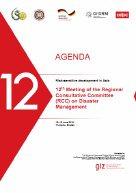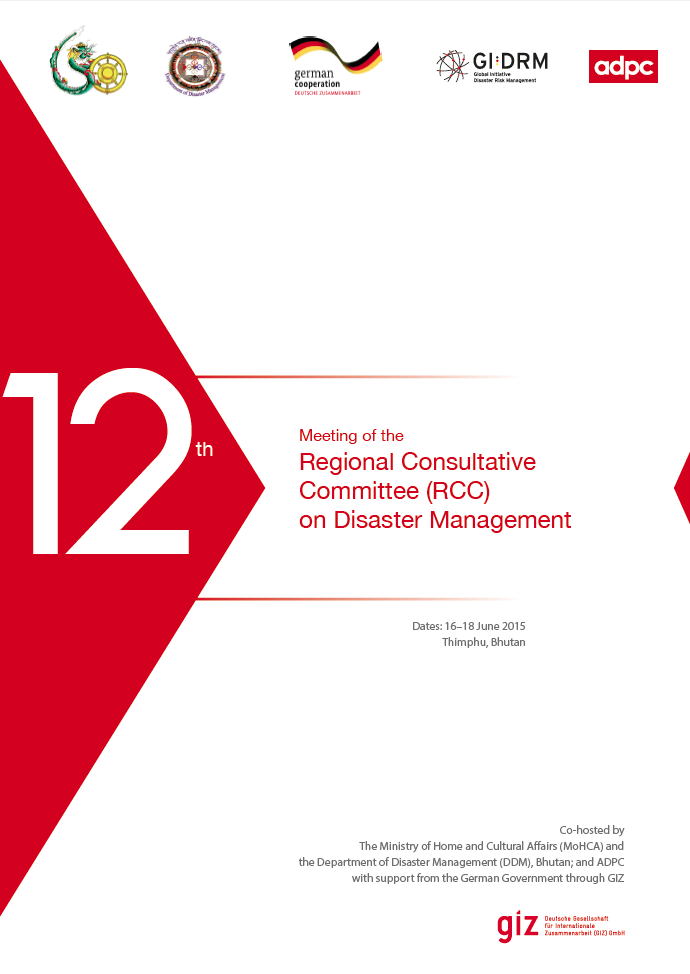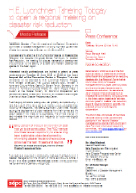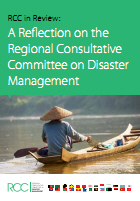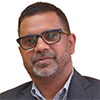12th meeting of the Regional Consultative Committee on Disaster Management
The 12th annual meeting of the Regional Consultative Committee on
Disaster Management (RCC) will be held in Thimphu, Bhutan on 16–18 June
2015. Organized with support from the German Government through GIZ, the
meeting will focus on the theme Risk-Sensitive Development in the
Asia-Pacific Region.
The members of the Regional Consultative Committee on Disaster
Management work in key government positions focusing on the development
of national disaster management systems in the Asia-Pacific countries.
Currently comprising of 26 countries in the region, the committee was
established in 2000 at the initiative of Asian Disaster Preparedness
Center.
Visit the RCC’s website
Documents
RCC12 Agenda
Published on: 06/15/2015
Department: General
Type: Conference and Workshop Proceedings
Language: English
RCC-12 Background Note
Published on: 04/28/2015
Department: Safer Development Planning and Implementation
Type: General
Language: English
H.E. Lyonchhen Tshering Tobgay to open
a regional meeting on disaster risk reduction
Published on: 06/16/2015
Department: General
Type: Media Releases
Language: English
RCC in Review: A Reflection on the Regional Consultative
Committee on Disaster Management
Published on: 06/12/2015
Department: General
Type: Conference and Workshop Proceedings
Language: English
The Regional Consultative Committee on Disaster Management (RCC) has emphasized on community-based actions to reduce risk since its very inception. The 2001 Bangkok Declaration by the RCC 2 meeting identified "building community-level programs for preparedness and mitigation" as one of the key action areas in promoting comprehensive risk management approach in the region.
The RCC 7 meeting held in Colombo, Sri Lanka in May 2008 focused on the theme Rights-based Community-led Disaster Risk Reduction. The discussions between the RCC member countries at the meeting reflected the evolving perspective of community-based disaster risk management with moves towards community leadership for DRR, and greater engagement and partnerships with local government mechanisms. As an outcome, the meeting affirmed the commitment of the RCC members to take up national programs on community-based disaster risk reduction in high-risk communities.
Building on this affirmation, the RCC 8 meeting held in Manila, Philippines in February 2010 discussed the theme Implementing National Programs on Community-based Disaster Risk Reduction. In-depth discussions were held between members of the committee on the possibility of the proposed National Programs, based on the experiences of the RCC member countries and the needs felt at the local level. The outcome of the meeting was the Manila RCC 8 Statement on Implementing National Programs for Community-Based Disaster Risk Reduction in High-risk Communities.
The RCC members recognized the importance of each of the above-mentioned program components for advancing CCA at the community level with the close linkage between DRR and CCA. The RCC 9 meeting in Phnom Penh, Cambodia adopted options for linking disaster risk reduction and climate change adaptation at the community level.
The last decade has seen an increasing progress in RCC member countries in strengthening institutional systems for DRR at the national and more importantly at the sub-national and local levels. Cohesive institutional frameworks are needed to collaborate within and between each government level for the implementation of the strategies. Many RCC member countries have attempted to decentralize the functions of DRR at the local level, and have thus adopted building capacity and strengthening local disaster risk reduction organizations.
With limited financial resources and capacity at the local level, it is absolutely imperative that local-level implementation of DRR and CCA be closely integrated with development interventions such as water resource management, community-based forest management, ecosystem-based livelihood promotion and micro finance. A new opportunity and obligation exists in the recently adopted Sendai Framework for Disaster Risk Reduction (SFDRR) 2015 - 2030 to reconfigure development strategies to include DRR and CCA and to adapt sustainably so as to not compromise future generations.
Linking both CCA and DRR at the local level will lead to increased effectiveness and sustainability of approaches, and to more efficient use of financial resources. Thus the existing institutions and systems of DRR at the local level can play a vital role in assisting the implementation of CCA. Based on experiences of the RCC member countries, the RCC 12 meeting should identify the roles of local DRR institutions and systems to advance the implementation of CCA as well as identify additional support required to facilitate this.
Aslam Perwaiz serves as Head the Disaster Risk Management Systems (DRMS) Department at Asian Disaster Preparedness Center.
References:
United Nations: Global Assessment Report on Disaster Risk Reduction 2011 (GAR 2011)
|
||||
| Achieving resilient development under the Sendai Framework for Disaster Risk Reduction | ||||
| We all have a reason to celebrate the great achievements under the Hyogo Framework for Action (HFA) during the past decade. By Irfan Maqbool |
Communities across Asia are now more receptive to disaster risk reduction (DRR) and are willing to adapt to climatic changes; governments are shying away from emergency response syndrome by establishing and strengthening DRR systems and structures; and development partners are far more eager to provide technical support to both governments and communities in achieving the underlying goal of 'resilient development.'
At the same time, however, the past decade also offers useful insights vis-a-vis risk- and climate-sensitive development, predominantly in the perspective of Asia. In this regard, Asian Disaster Preparedness Center (ADPC) initiated a 10-year flagship program on Mainstreaming DRR into Development (MDRD) in 2004, with support from the Department of Foreign Affairs and Trade of the Government of Australia and under the Regional Consultative Committee on Disaster Management (RCC). Based on learning from the MDRD program that was implemented in more than 15 countries throughout the region, some interesting issues and options are outlined below �€“ many of which were widely discussed at the World Conference on Disaster Risk Reduction earlier this year.
First, development is too political, and at times, constituency-driven. More often than not, the political or elected leadership of a country dictates development decisions be it a macro program or a small project or scheme. Politicians (read policy- and decision-makers) have their own time-bound agendas, political commitments, priorities and limitations, which leave little room for them to participate in DRR and climate change discourse. It is, therefore, critical for the development partners, academia, media, and civil society organizations to consciously engage with the political leadership for the sake of making risk-inclusive development an integral part of their thinking as well as the development decision-making process.
Second, governance systems are usually intricate along with the development planning and implementation processes. Without fully understanding and analyzing the governance system of a country within which overall development takes place, identification of appropriate DRR and climate change entry points will continue to be a challenge. Also, it would be useful to appreciate the fact that each country has its own governance and development dynamics, which may require country-specific approaches to risk-inclusive development rather than applying a standard framework.
Third, public-sector development planners, financial controllers and disaster managers find it challenging to make a convincing point for the policy and decision-makers with regard to investing in DRR and climate change in the absence of a solid evidence of 'returns.' For this to occur, the development of country-specific frameworks for assessing the impact of such investments both in qualitative and quantitative terms seems to be critical. These impact assessment studies can always serve as useful policy advocacy tools. That is also where we can potentially see a role for the mainstream, local and alternative media, which can effectively help exert pressure through public discourse on the subject.
Fourth, over the past ten years, the HFA has successfully laid down the foundation for implementing more specific actions under the post-2015 framework in terms of mainstreaming DRR and climate change considerations into development planning. In this direction, a robust needs assessment of key sectors at national and sub-national levels may prove to be handy for the resilient development agenda to prosper.
Fifth, risk assessment has almost become a buzzword and a number of countries have carried out risk assessments of varied categories and types in one way or the other. The fundamental challenge, however, is on the usability of such risk assessments. Perhaps, more emphasis needs to be placed on making the risk information usable for the development planning officials. It would require the development of tools and methodologies for processing and packaging the risk information compatible with the development framework of a country.
Sixth, HFA helped promote the implementation of community-based disaster risk management (CBDRM) at a much wider scale. Building on it further, it would be best to explore the technical and operational possibilities of linking the CBDRM framework and its outputs with the local-level development planning institutions. It will not only help sustain the community-level initiatives, but also contribute to introducing and strengthening the resilient development agenda at the local level.
In addition to the above points, it will be equally important for national governments to opt for a robust accountability mechanism. This will lead to a more transparent assessment of their efforts, which in turn will contribute to better risk governance.
Mr. Irfan Maqbool serves as Head of the Safer Development Planning and Implementation Department of Asian Disaster Preparedness Center.
|
||||
| Have we learned to govern risk better? | ||||
| 15,000:107. These two numbers are the death counts for two cyclones that hit Bangladesh, Cyclone in Sidr (2007) and Mahasen (2014) respectively. By Alexander Barrett |
This is a common trend in other countries too, but because of the irregularity of the magnitude and frequency of disasters, it is extremely difficult to show that directly with numbers. However, if you were to ask your average government official ten years ago: "what is DRR?", the majority would have given you a blank stare. I believe this is not the case anymore.
I will use Bangladesh again as an example, where awareness and understanding of DRR has grown significantly over the past ten years. Bangladesh did not start preparing for disasters only in 2005, but the Hyogo Framework for Action (HFA) gave it a constructive approach for how to combat this constant problem through DRR initiatives. Under the HFA, Bangladesh has developed a number of policies and programs to govern the risk of disasters at a national level including the National Plan for Disaster Management 2010 - 2015 and the Comprehensive Disaster Management Programme (CDMP).
Disaster risk however is not static and new growing risks will need to be addressed. Climate Change is now accepted as a global problem that will cause more frequent hydro-metrological disasters of greater magnitude and a rise in sea level. Population growth combined with rural-urban migration will mean that addressing urban-specific risks will need to be higher on development practitioners' agendas.
Combating disaster risks will be harder in the next decade, but we have never been in a better position to be able to tackle it. The new Sendai Framework for Disaster Risk Reduction (SFDRR) gives an approach for all actors in the field of DRR to work together to address these issues. The private sector, overlooked in the last decade, is now engaged as a crucial actor to ensure resilient development, risk governance has new tools and methods at its disposal to counter the new risks, and awareness of decision-makers has also increased in the last decade creating a political will for disaster risk reduction initiatives to be prioritized.
Mr. Alexander Barrett serves as Programme Coordinator with Asian Disaster Preparedness Center.
|
||||
| Fast-tracking Post-Disaster Needs Assessment | ||||
| Recovery and reconstruction provide an important window for ex-post investments towards mainstreaming disaster risk reduction into sustainable development. By Aslam Perwaiz |
Despite reasonable success and improvement in PDNA tools and techniques in the region over the past decade, they are hardly adopted by countries as part of their post-disaster assessment systems. In the aftermath of disasters, national governments generally make an estimation of the cost of reconstruction based solely on the value of destroyed physical assets -- mostly buildings, roads, bridges etc. Until recently, little attention has been paid to the social and human development impacts caused by disasters, and the recovery costs to achieve normalcy after such events. There is a tendency to overestimate or inflate some of the damages, while at the same time, there is also under-estimation of the damages in some sectors. The damages in other few sectors are sometimes totally ignored.
There is a lack of institutional and human capacity that has been the constraining factor in adopting and institutionalizing the PDNA methodology into the national disaster damage and loss assessment systems. Further, in recent times, there has been an emerging trend to conduct rapid assessment of disaster impacts by downscaling PDNA and attaching priority to the context-specific and limited sectors for the assessment. The rapid assessment is driven by the advances in technology innovations, particularly space applications, geographical information systems (GIS), statistical time-series analysis/simulations and semi-empirical loss assessment models such as ShakeCast and Early Post-Earthquake Damage Assessment Tool (EPEDAT) for potential earthquake damage assessment. With smart tools and techniques, the rapid assessment contributes substantially to the PDNA process in case the government and development partners in the due course take it up.
Geospatial information systems and satellite imagery have a huge potential and hold the key to developing new methods, tools, and modules for disaster assessment. It helps to obtain timely, relevant, and accurate information regarding the geographic location and spatial extent of areas affected by a natural disaster, including a preliminary damage estimation of human and physical assets. The use of satellite imagery can be a very cost-effective way to collect disaster damage information and often represents the only source of synoptic information available within affected remote and less developed areas in the immediate aftermath of a disaster.
It is important to understand the limitations as well as the comparative advantage of space applications, GIS and other existing tools and technologies. Along with using them strategically and in conjunction with other sources of information, it is also important to understand that a source of information is quite critical and has to be used as evidence-based in post-disaster situations.
The South Asian Association for Regional Cooperation (SAARC) Disaster Management Centre, mandated to promote regional cooperation for disaster risk reduction, envisages putting in place a hierarchical framework facilitating the integration of science and technology inputs into disaster risk reduction practices, including disaster assessment and recovery. To address this issue, a collaborative effort is underway to develop a common regional protocol for PDNA in the SAARC member states by involving regional institutions such as the United Nations Office for Disaster Risk Reduction (UNISDR), Global Education Training Institute (GETI), International Recovery Platform (IRP), United Nations Economic and Social Commission for Asia and the Pacific (ESCAP), United Nations Development Programme (UNDP) and Asian Disaster Preparedness Center (ADPC) through an extensive consultative process and workshops with various experts and representatives from the SAARC member states. ESCAP has responded to the request of SAARC Disaster Management Centre to develop a systematic and scientific approach for assessing disaster damages, losses and needs for the SAARC region.
Aslam Perwaiz serves as Head the Disaster Risk Management Systems (DRMS) Department at Asian Disaster Preparedness Center.
|
||||
| Behind facts, figures and stats stands a confident woman doctor | ||||
| In Bangladesh, gender inequality and inequity is prevalent across most population segments. Progress has been made through introduction of interventions and government commitment to bringing women into mainstream economic activities and working towards equal opportunity. By Maria Holtsberg |
However, the women doctors involved in USAID's Strengthening Earthquake Resilience in Bangladesh project, funded by USAID Bangladesh and implemented by Asian Disaster Preparedness Center (ADPC), paint a different picture. They display confidence, command and equal opportunity to excel in their craft. There are probably many factors for this, some inherently due to a personal drive, others linked to continued family support and encouragement. Despite statistics and evidence of a marked male bias within the doctor profession in Bangladesh, the doctors I met show a different picture, one of empowerment and full confidence in the professional capacity.
Dr. Asita Ali from Chittagong General Hospital just came out from surgery wearing her scrubs and hair tied up to meet me to discuss her job and share her thoughts about women doctors. She spoke in a commanding voice with bright alive eyes. There was very little indication that this woman struggled to achieve her goals. She looks like she was born to wear scrubs and own an operating theatre. "I want to be a doctor to serve my people," she told me.
Dr. Ali was trained in the ADPC-implemented courses entitled Hospital Preparedness for Emergency Response (HOPE) and Hospital Incident Command Systems (HICS). She also participated in the Hospital Risk Assessment conducted for her hospital and has been closely involved in making developments in her department and the hospital as a whole.
"I have grown as a leader, the training has allowed me to learn how to command my operating theatre," she explains. While the technical knowledge comes from years of medical school, residency programs and hard work, the HOPE training focused on how to deal with patients, how to develop a command system, how to work in interdisciplinary teams. "The training has shown so many benefits to us, from top to bottom," she tells me.
Behind every successful person are the people who are the enablers, the champions, the persons to support, encourage and facilitate. For women, who are often fighting against gendered stereotypes, socio-cultural expectations and other barriers, there needs to be people around them who support and push them to challenge and overcome these barriers.
Dr. Asista Ali credits her mother as her main support. "My mother is a housewife and she pushed me to become a doctor. She made me very self-dependent," she told me. "By contrast, my father did not support my choice to become a doctor, he thought it was too hard work." Dr. Ali did not listen to her father but continued her studies.
Another doctor that I met is Dr. Reshma who works in the Shaheed Suhrawardy Medical College Hospital, also trained by ADPC and leading many important hospital preparedness processes in her hospital. She is an example of how important it is to have a strong support network to fulfill goals. She has three young children yet she managed to complete her studies and residency program, and works as a doctor without any gaps.
"I have great support from my husband who works in the corporate sector," she told me. Their three children were cared for by her mother-in-law. "My mother-in-law was illiterate but pushed me to pursue this work, when I needed something, I always felt her soft hand, she died last year and I am a bit lost without her,"�‚�� says Dr. Reshma with sad eyes.
Meeting these women serve as a reminder that behind facts and figures, analysis and discussions, there may be a strong, confident and empowered woman who will take the skills and opportunities given to her and change her world. If this is not enough incentive to push for gender-balanced training courses on hospital preparedness, nothing is.
Maria Holtsberg works as Project Manager in the Public Health in Emergencies Department at Asian Disaster Preparedness Center.
